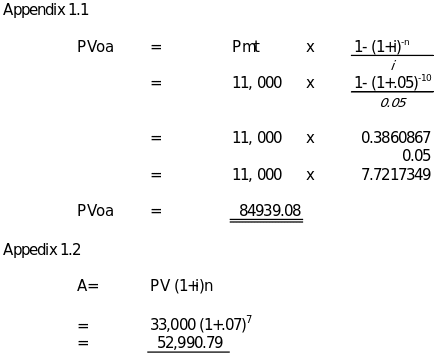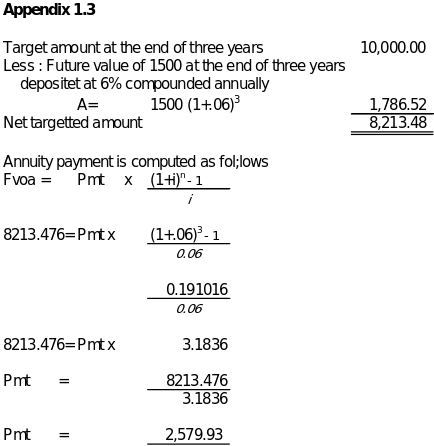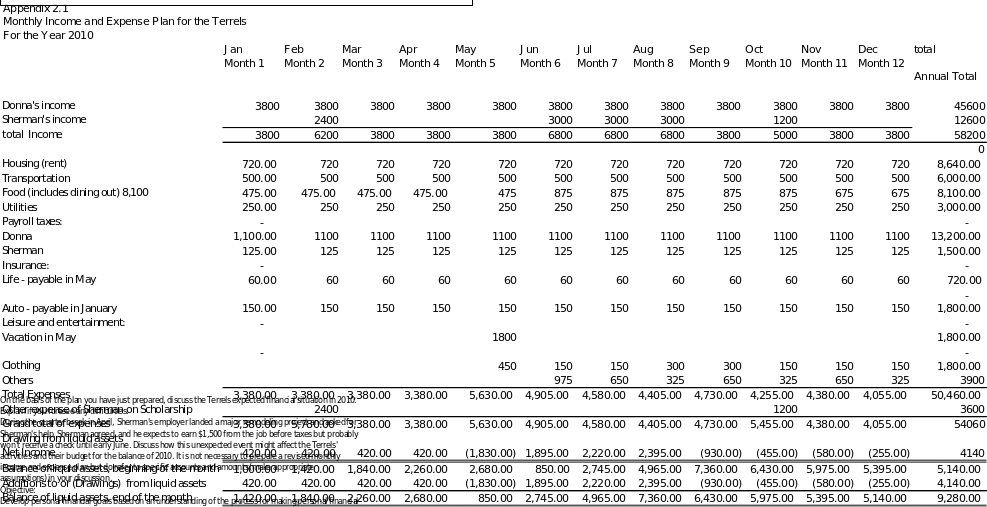Mary and Joe
For the court to be able to be able to pay Joe $11,000 each year for the next ten years, it must invest the present value of an amount that would earn 5% compounded annually. This assumes that all the payments for the $11,000 will be made at year ends and nothing will be left in the account after the final payment. The formula of the getting the correct answer is to bring the streams of $11,000 to their present value as computed in Appendix 1.1. The present value as computed $84,939.08 is smaller in amount than adding all the total of $11,000 that would be given for 10 years or $110,000. This is because, the time value of money asserts that the value of $1 dollar received today is higher than the value of $ received one year from now or any other latter period.
Mary will have saved the amount of $52,990. at the end of the seventh year as computed in Appendix 1.2. The amount is computed by the future amount of $33,000 invested today to earn 7% at the end of seven years , compounded annually. The formula and computation is as shown in Appendix 1.2. This is different from that computed 1.2 since this is about the future amount that would be assumed start from a present amount to be invested at a single amount not on a per period or annuity basis. However since the amount will be allowed to stay for seven years, an annual compounding of interest is assumed.
Since Mary and Joe are desirous of saving the amount of $10,000 by the end of three years and they have already the amount of $1,500 as starting value of their saving account, the latter amount should be computed as to its future value if the same is invested at 6% compounded yearly at the end of three years. From the $10,000 as targeted amount, the future value of $1,500 as computed at $1,786.52, should be deducted and this would give the net amount of $ 8,213.48 as computed in Appendix 1.3. The same net amount has it equivalent annuity payment using the formula for computing future value of an annuity payment as done in Appendix 1.3. The annuity payment as computed is $2,579.93 representing the equal amount to be deposited yearly in order to have the value of $8,213.48 to be added to the future of current savings amount of $1,786.52. This would allow the spouses to have $10,000 at the end of three years as targeted.
Sherman and Terrel
The monthly income and expense plan for the Terrels in 2010 would be as shown in Appendix 2.1.
The difficulties in preparing the monthly income and expense plan comes from the need to accomplish some objective like the vacation in May in 2010, that would need about $1,800 when there are conditions that must be satisfied. One of these conditions is that the liquid assets of the beginning of 2010 should be made lower than $600 if there drawings to be drawn from the said amount. There was therefore a need to sacrifice expenses at the earlier part in order to be able to meet the target for the $1,800 for May, 2010. In preparing the initial plan, there was the need to divide the annual income of Donna and spouses’ estimate of expenses into 12 twelve months. The plan also involved putting the specific amount if income that Sherman will earn at given particular months. There was also the need to include the scholarship payments of $2400 in February and $1,200 in October 2010 as part of both expected income and expenses since the same are benefits and cost effectively for the spouses. The total monthly income and total monthly expenses are compared and if income is higher, there would be net income. Otherwise, there would be a loss. In case there is income, the same is assumed to be added to the available liquid assets of $1,000 at the beginning of 2010 and if the same is a loss , or when monthly expenses is higher, the amount will be considered a drawing for the month that could reduce the available balance of liquid assets.
What made the plan difficult is the need to keep the ending monthly balance of liquid assets to be not below $600 for each month after reflecting the effect of net income or net loss for the period. Since using the initial amount of expenses resulted to below the $600 cut off, there was need to move expenses to latter period in order to meet the targeted balance. Among the expenses, priority was given to less necessary expenses such the other expense and less priority was given to basic needs that must be met like housing for the rent, transportation expense that would have to paid since these spouses would have to go place of work, food and utilities. After moving some of the amount of other expenses and clothing to latter periods, below the $600 cut off in the liquid assets was still appearing, thus there was need to move some amounts from food since the estimated equal amount including dining out expenses. But since it was assumed that vacation expense of $1,800 must be met by all means, there was the need to make some sacrifice for some of expenses at the earlier months and moved them after May when the earnings of Sherman would have helped increased the net cash inflows of the spouses. The sacrifice needed some movements also in food expenses which mean that the spouses would have to postpone their desire to have dine-outs. They would just have to eat at home basically during the January to April and keep dining out at the minimum. But at it turned out, staring in June, 2010, the cash inflow from Sherman would greatly help the budget of the spouses.
This would also mean that if the spouses would cancel the vacation or move to some latter period, like after August when Sherman’s income would have come, the spouse do not need to make sacrifices in other expenses, clothing and food as shown in appendix 2.1
The expected earning in June could really help the spouses in increasing cash flow, but it would have been better if it was received in May or before the said month because that was where funds were negative initially which necessitated postponement of some expenses after May because it was assumed that the may vacation was not negotiable.
Marcia and Phil Helm
I feel the Helm’s $9,500 liquid balance is inadequate since that amount just approximates two months the total of their combined take home pay of about $5000/month. This would mean that they just have a buffer amount of two months salary after having been married for several years. Since the case does not state how much could they really save from their combined salaries, it can be inferred that they were saving very little and that their earnings are just for the necessary expenses.
To understand, the relative risks and potential advantages of CDs, there is need to look at it in terms of the amount of interest income that the investment promises as against alternative investment options and the deprivation period or incapacity to use the money for current expenditures. The advantages of CD would include a fixed rate of interest that is usually higher than a saving interest rate that it can be insured a certain amount. Since risk of investment in CD is being lower than the many other kinds of investments like stocks, the expected rate of return is lower than a stock investment. There is therefore a trade-off between risk and return. A conservative investor would choose a CD investment while an aggressive one would take a stock investment. CD investment is recommended for Helms if they have extra amounts that they may not need in case of emergency. Given that they their extra money is only good for two months, placing them in CD investment may deprive them of the use of the money in case of sudden loss of job of either of spouses. If they can arrange a lower period of CD investment like a 30-day term, the can still avail the same but if they pre-terminate the investment, they could be subjected to some penalty charges that could result to loss on possible earnings instead. The penalty is to discourage withdrawal of investment earlier than the term of the CD.
I believe that investing their money at the stock market is still premature because of the amount of savings that they have in relation to their needs for fund at any time when one or two of them loss employment. Investing in banks may give a lower amount but the investment is safer and they could always use the same amount if the same is placed in savings account. Investing in stock is risky and only extra funds that would be used for emergency needs should be invested by the Helms.
The recommendations for cash management plan for the Helms would include the following: First they should know how much is their monthly expense and income. They must prepare a budget on a monthly basis and identify their possible sudden needs for cash. They should set a minimum amount in the bank so that they could not be found having zero balance. They should provide some insurance for their life, health and properties. They should live in with their means and invest only extra amounts in those where they could accept the risk and without affecting their emotional stability when problems suddenly arise. They should place their money where there could use the same without getting unnecessary risks.
To apply these guides in the instant facts for the Helms, investment in CDs with long term maturity is not advisable to them. Investing in money market may be too risky for them because of low savings. Investing in Super NOW account may offer 3%, higher then the present savings rate of 2.5% saving rate which their money enjoys, but it could deprive them the use of the money to the extent of $2,500 as minimum balance but the same will earn still 2% interest if balance would be below the said amount. The problem however could arise when everything can only be withdrawn by check and some payees are not ready to accept checks.



